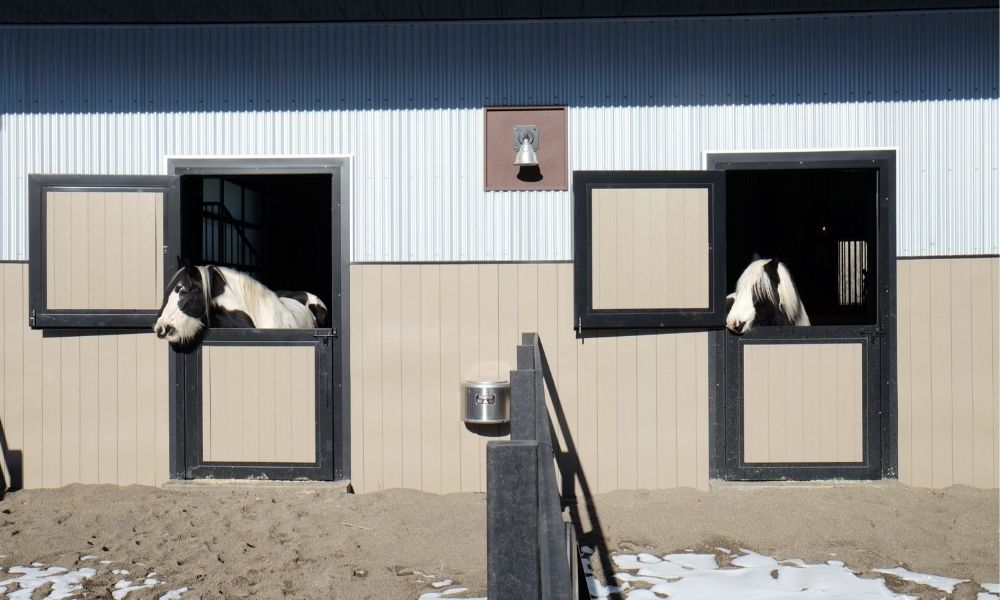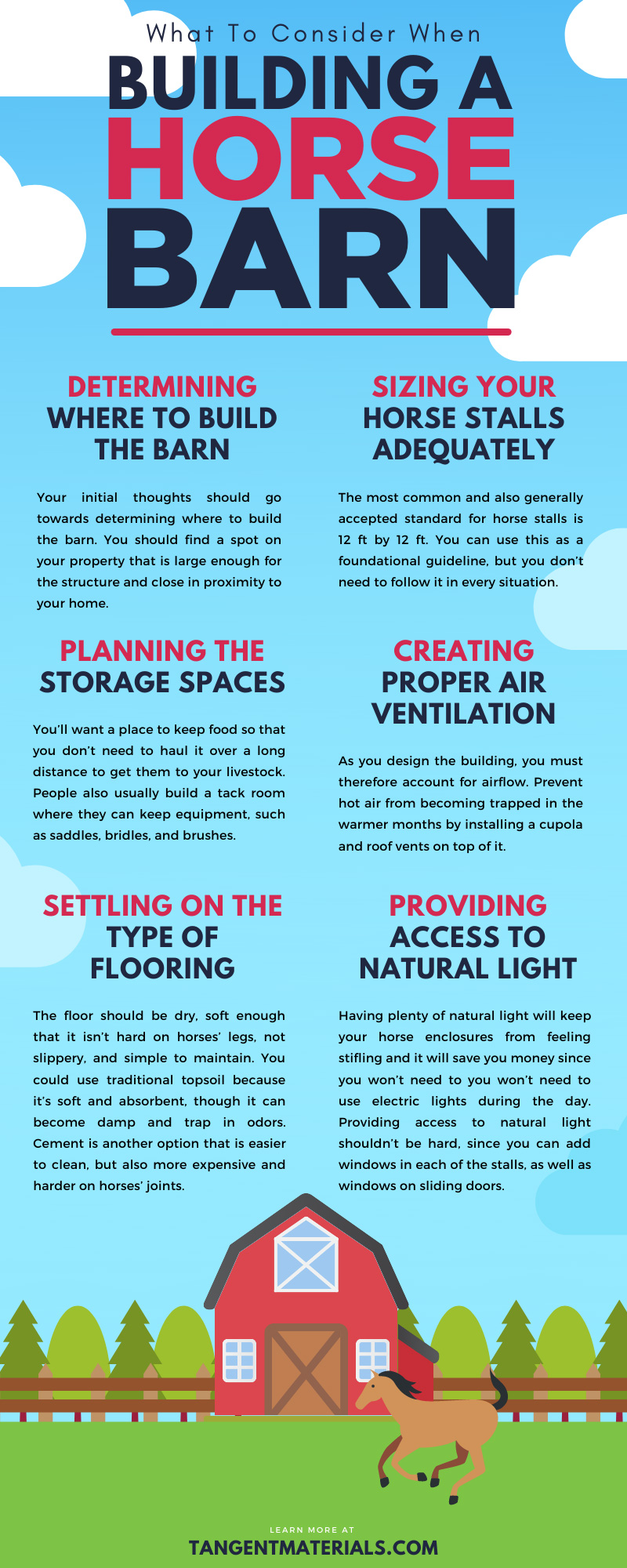What To Consider When Building a Horse Barn

If you want to raise horses well, you’ll need to construct a horse barn and fencing to provide them with shelter and protection. At a glance, this task might not seem all that complex, but in actuality, there are numerous considerations that you must make when designing an enclosure for your equine friends. Thinking about all of them will help you ensure that the horses are happy and healthy. A strong structural design will also allow you to go about your routine activities without experiencing any frustrating hindrances. Unearth what to consider when building a horse barn by remembering the following points.
Determining Where To Build the Barn
Your initial thoughts should go towards determining where to build the barn. You should find a spot on your property that is large enough for the structure and close in proximity to your home. With the horse barn nearby, you won’t need to walk far out for every instance where you go to see your horses. This is essential because activities like feeding and grooming will necessitate that you visit them several times each day. In addition, having it close to your house, you should also reflect on the ease with which you can turn out your horses to your pastures.
Sizing Your Horse Stalls Adequately
After selecting an ideal location, you should figure out the details relating to the stalls within the barn. One of these factors is the size of the stalls. The most common and also generally accepted standard for horse stalls is 12 ft by 12 ft. You can use this as a foundational guideline, but you don’t need to follow it in every situation. When your horses are of a larger breed, they may require more space than this to stay comfortable. Furthermore, should you plan to keep broodmares, you’ll need wider stalls as well. The reason for this is that the mares and their young foals will need to stay together.
Deciding on the Number of Stalls
The number of stalls is another factor to deliberate over. To decide on it, you should ask yourself how many horses you want to and feasible can care for at present. You should also look to the future and consider whether you plan to keep more horses later on. The goal is to find a balance between having enough or maybe a little extra room, while also keeping costs low. If you underestimated the number of stalls, you’ll need to go back and build more later on, which can be a big hassle. On the other hand, if you overestimate, you may end up spending more money than you need to and have stalls that you never use.
Planning the Storage Spaces
Other than the stalls, consider building your horse barn with storage spaces. You’ll want a place to keep food so that you don’t need to haul it over a long distance to get them to your livestock. People also usually build a tack room where they can keep equipment, such as saddles, bridles, and brushes. The tack room and the food storage room should have walls and doors that keep them from becoming too dirty or wet. Prolonged moisture can damage leather items and cause food to rot.
Creating Proper Air Ventilation
Just as a room without air circulation can get oppressively stuffy, a horse shelter that doesn’t have proper air ventilation can be uncomfortable and even harmful to horses. As you design the building, you must therefore account for airflow. Prevent hot air from becoming trapped in the warmer months by installing a cupola and roof vents on top of it. A cupola can actively move hot air out as it rises upward with a fan, while vents will provide passive circulation routes. Facing windows and doors in the direction that wind blows in your area will also promote ventilation.
Including a Wash Bay Area
For convenience, it’s nice to have a wash bay within your horse barn. A wash bay would include a showerhead and enough room to keep cleaning supplies. There should also be a drain and concrete flooring since the area will get soaked. You should place the wash bay away from your tack room and food room because, as mentioned earlier, you don’t want those to be exposed to lots of moisture. At the same time, note that building the wash bay close to your home’s bathrooms or its laundry room will make construction easier since there are already existing water lines there.
Settling on the Type of Flooring
Flooring is an important part of what to consider when building a horse barn. The floor should be dry, soft enough that it isn’t hard on horses’ legs, not slippery, and simple to maintain. There are many options of flooring to choose from, each with different advantages and disadvantages. You could use traditional topsoil because it’s soft and absorbent, though it can become damp and trap in odors. Cement is another option that is easier to clean, but also more expensive and harder on horses’ joints. People often cover cement with rubber mats to counteract its firmness. There are other materials as well, so be sure to do your research before settling on one.
Providing Access To Natural Light
Having plenty of natural light will keep your horse enclosures from feeling stifling and it will save you money since you won’t need to you won’t need to use electric lights during the day. Providing access to natural light shouldn’t be hard, since you can add windows in each of the stalls, as well as windows on sliding doors. Windows double as routes for air to circulate as well, making them doubly beneficial to have.
Utilizing the Right Building Materials
The materials you use building a horse barn is pivotal to its effectiveness. You need the barn to be strong and long-lasting. Metal can function satisfactorily because it’s tough and relatively easy to maintain. For bars and grate structures, metal is a good choice. Wood is another material that many people turn to when constructing horse shelters because of its versatility and visual appeal. However, it has some glaring weaknesses. For one, horses can chew on lumber if it doesn’t have additional guards on its edges. Wood can also rot when in contact with water. Though you can treat it with chemicals to stop this, periodically needing to do so can be a bother.
Thankfully, plastic lumber exists to cover over all these shortcomings. This material is made of recycled HDPE plastic and has a similar appearance to normal lumber. It can fulfill all your structural needs and isn’t vulnerable to water, sunlight, or activities like chewing. You can also easily disinfect and clean plastic lumber because it’s impervious to moisture absorption and won’t house bacteria as some wood fibers can. Sweeping, scrubbing with water and soap, and pressure washing are all viable options for removing dirt and debris. Due to its resistance to outdoor forces, keeping it in good condition over the years isn’t a labor-intensive task. With a range of earthy brown colors to choose from and the option to mold grain patterns on its surface, plastic lumber provides all the aesthetic advantages of wood without any of the drawbacks.
Acquire plastic building materials to use in your horse barn by contacting Tangent today. We’ll be happy to answer your questions about how you can use our plastic lumber in equine applications.













